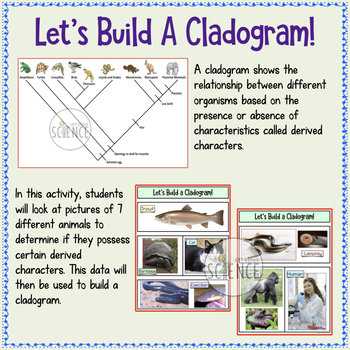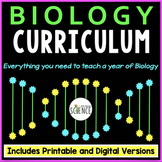Cladogram Activity - Classification of Living things
- Zip
- Google Apps™

What educators are saying
Also included in
- This complete teaching unit on classification and taxonomy includes everything you need to teach this unit to your life science or biology students. Many of the resources are available in BOTH printable and digital formats. Resources include a 71-slide PowerPoint presentation packed with colorfulPrice $43.99Original Price $58.71Save $14.72
- This NO PREP, PRINTABLE, EDITABLE, AND DIGITAL Biology Curriculum contains everything you need for an entire year of Biology! For less than $3 a day, you can save your time, energy, and sanity. Each of the 20 Complete Units includes a teaching PowerPoint presentation, notes, labs, homework assignmenPrice $525.00Original Price $988.18Save $463.18
Description
This printable or digital problem solving activity teaches students how to build a cladogram and reinforces the important concepts of cladistics to your biology or life science students in grades 8-12. I use this activity when teaching my unit on classification and taxonomy, but it would also be appropriate to use during your lessons on evolution and natural selection. Both printable and digital versions of this resource are included. The student handouts can be printed or used in the paperless digital format in your Google Drive, Google Classroom, Microsoft OneDrive, or similar. This resource is perfect for traditional classroom settings, 1:1 schools, or distance learning.
What is included in this resource?
- Printable and Editable Handouts for Students
- Digital paperless version (not editable) for use in Google Drive, Google Classroom, and/or Microsoft OneDrive
- Full-color, high-quality photos of animals used to develop the cladogram
- Teacher Guide and Answer Key
What is cladistics? Cladistics is one of the newest trends in the modern classification of organisms. It shows the relationship between different organisms based on the presence or absence of characteristics called derived characters. In this activity, students will look at pictures of 7 different animals to determine if they possess certain derived characters. This data will then be used to build a cladogram.
This product comes with a student-friendly explanation of cladistics and definitions of key terms related to cladistics. Picture file of 7 different organisms is included. The 4 page student worksheet leads them through the process of making observations, completing a data table, and using this data to complete the cladogram. There are 19 follow up questions, and complete answer key for the teacher.
Not only does this activity teach cladistics, but it reinforces the skills of observation, problem solving, analysis, and critical thinking.
This activity was written for my high school Biology I class, but is also appropriate for middle school students. You will receive both a pdf file and a Word document so that you can make changes to it to suit your needs. Please note: Student handouts are editable, but the images used in this resource are not editable.
Related Products Include:
Classification and Taxonomy Complete Unit Plan Bundle
Classification PowerPoint and Notes Set
Dichotomous Classification Key to Thanksgiving Dinner
Classification Using a Dichotomous Key
Insect Dichotomous Key Activity
Darwin's Theory of Evolution PowerPoint and Notes
Test: Classification and Diversity of Life
Kingdoms of Life Mix and Match Card Game
Lab: The Use of Dichotomous Keys in Classification
Dichotomous Key to the Genus "Smiley"
Evolution and Classification: Warm Ups, Bell Ringers and Interactive Notebooks
Dichotomous Classification Key to a "Crazy" Animal Kingdom
Learning to Use and Construct a Dichotomous Classification Key
Classification and Taxonomy Task Cards
Classification Crossword Puzzle
Classification (Taxonomy) Homework or Study Guide
Classification and Taxonomy Jeopardy Review Game
Classification and Taxonomy Quiz
Earth's History and the Origin of Life on Earth PowerPoint with Notes
Free Dichotomous Classification Key to Holiday Giving and Community Service
For updates about sales and new products, please follow my store:







